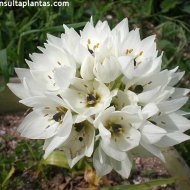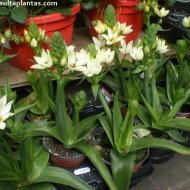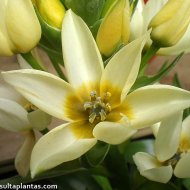Care of the bulbous plant Ornithogalum thyrsoides or Wonder-flower |
|
The genus Ornithogalum, family Asparagaceae, includes 180 species of bulbous plants native to the Mediterranean region, Asia, Africa and South America. Some species are: Ornithogalum thyrsoides, Ornithogalum dubium, Ornithogalum umbellatum, Ornithogalum arabicum, Ornithogalum nutans, Ornithogalum caudatum. Common names: Wonder-flower, Chinkerinchee, Chincherinchee or Star-of-Bethlehem. This species is native to South Africa. They are herbaceous plants with large rounded bulbs that reach 50 cm (19.68") in height. They have fleshy, lanceolate, glossy green basal leaves. The attractive, upright inflorescences are filled with white or cream-colored flowers with greenish or dark centers. They bloom from late spring to early summer. Wonder-flower is used in borders, in borders, in pots for patios and terraces, as indoor or greenhouse plants and as a cut flower due to the long duration of the flowers. If grown indoors it needs good ventilation. Ornithogalum thyrsoides prefers full sun exposure and a warm climate. It does not resist frost. The soil can be a normal well-drained garden soil with coarse sand and containing organic matter. Transplant each year at the beginning of spring to renew the substrate. Water regularly, waiting until the substrate has almost dried. In summer, after flowering, do not water because the plant goes to rest and the leaves die. In autumn water again so that it begins to grow, as well as in winter. Fertilize with compost in autumn. Star-of-Bethlehem does not need pruning. Ornithogalum thyrsoides is a plant resistant to the usual pests and diseases. Chinkerinchee is propagated from seeds sown in autumn or spring and by separation of bulbils if the mother plant produces them. |
Images of the bulbous plant Ornithogalum thyrsoides or Wonder-flower |
Find plants
Ornithogalum thyrsoides or Wonder-flower | Care and Growing
© 2026 FavThemes


